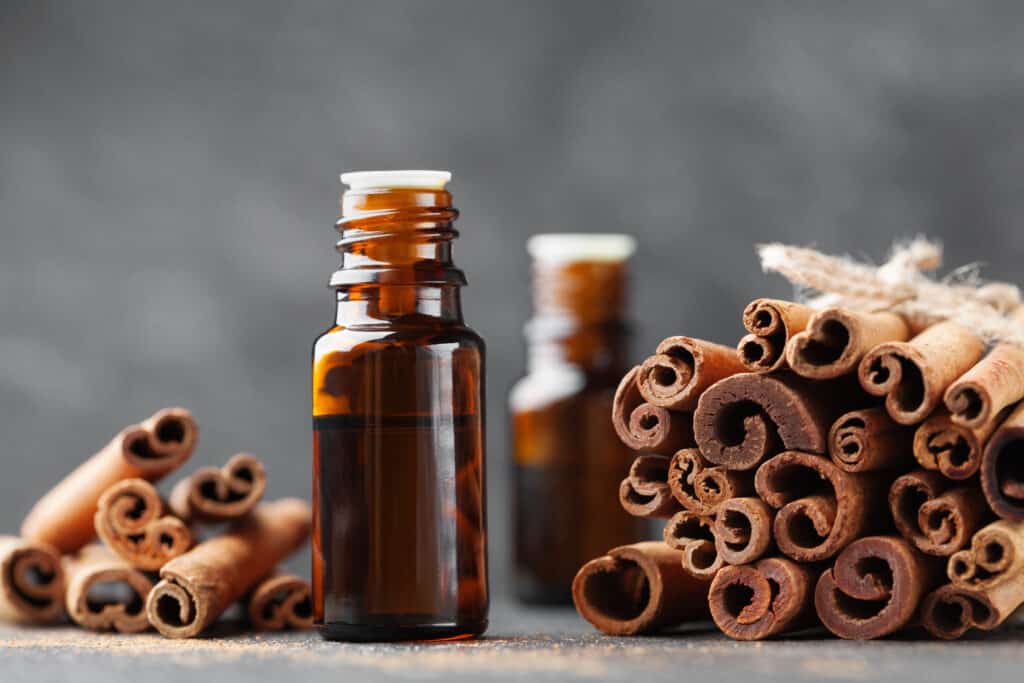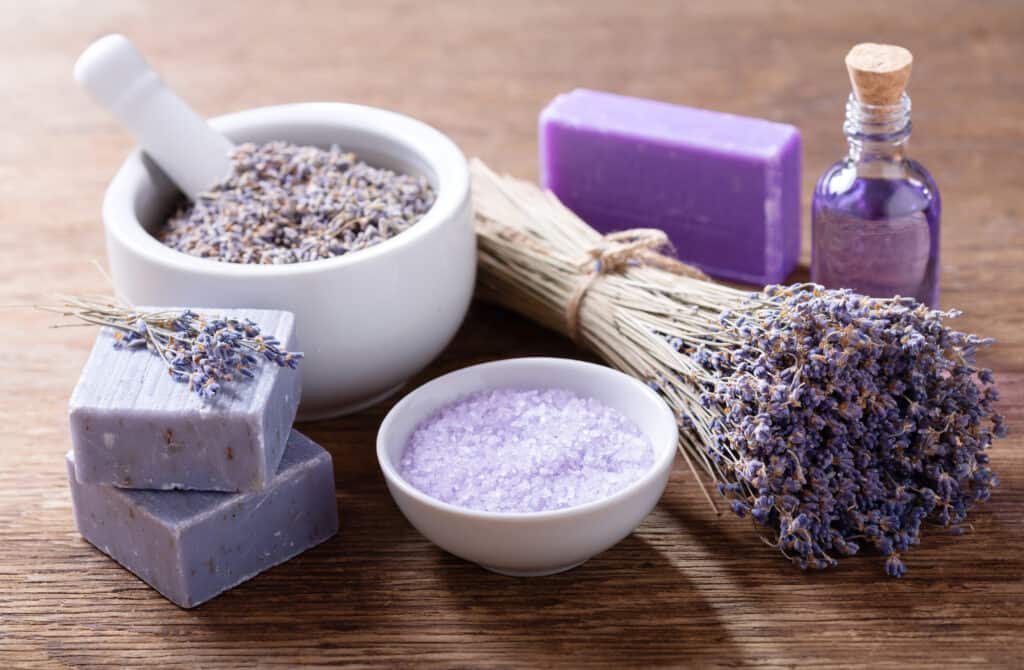Found in over 200 plant species including cannabis, linalool is a common, naturally occurring terpene alcohol. It manifests in either of two enantiomers that differ slightly in scent and taste characteristics. (S)- linalool, the more floral of the two, is common in lemongrass, coriander, and sweet orange flowers. Conversely, (r)- linalool presents itself with earthier, light spicy undertones and is recognized in basil, birchwood, peanuts leaves, and lavender where it can make up almost 60% of the terpenoid profile.
Plants use linalool’s antimicrobial, antioxidant, and antifungal properties to protect themselves from harmful diseases and pests. For apples, one benefit of linalool is its targeted volatility against codling moths.
As you can imagine, its vibrant aromatic characteristics make it a preferred additive to most scented consumer products. Linalool’s essence is present in 60-80% of perfumed goods, and there’s a strong chance that it’s used to fragrance your favorite household cleaners, detergents, lotions or soaps.
Many everyday products with linalool-heavy additives advertise calm, relaxing effects. While there is evidence of the benefits of aromatherapy, Linalool deserves major credit for providing the tranquilizing qualities of many fragrant herbs. Ever reach for your favorite lavender bath salts after a long day, or light a rose-scented candle to set a relaxing mood? If so, you’ve made a wise choice. Linalool extracted from lavender was able to lull mice to sleep during a 2008 investigation of its anxiolytic effects, verifying its unwinding role in self-care routines and relaxation rituals that utilize flowers and herbs rich in the sweet-smelling terp.

In cannabis, linalool is known for its spicy lavender aroma and calming effects. Linalool heavy strains like Granddaddy Purple, Do Si Dos, Lavender, and Kosher Kush are often recommended for individuals experiencing symptoms of stress and anxiety. These strains are also known for their ability to ease chronic pain, thanks to their high levels of myrcene, caryophyllene, pinene, and linalool.
Clinical research identifies linalool as a powerfully therapeutic terpene with the potential to treat a variety of physiological symptoms and neurological conditions.
In the US, the most common use of medicinal cannabis is for the treatment of moderate pain, and linalool certainly does its part combating inflammation and subduing chronic discomfort. Linalool has been found to reduce pain signal transmission by inducing antinociception, the body’s natural pain-blocking response to potentially dangerous stimuli, and acting on the opioidergic and cholinergic systems. A 2002 research study demonstrated that linalool and its corresponding acetate, linalyl acetate, seemed to reduce carrageenin-induced edema in rats, a classic example of inflammation.
When it comes to patients seeking mental relaxation, linalool has been shown to ease anxiety without any side effects. In a study of the anxiolytic potency of leaf essential oils, the brains of mice orally administered a corn oil blend consisting of (r) and (s) linalool from cinnamon leaves showed decreased serotonin, dopamine, and norepinephrine levels- indicating anxiolytic effects.

Currently, researchers are studying the benefits of linalool as a treatment for adults with chronic neurological conditions such as Alzheimer’s Disease and epilepsy. In a review of the potential use of pinene and linalool as nootropic medicine, linalool was found to have a non-intoxicating, psychoactive influence on multiple neurotrophic and inflammatory signals in the brain. Linalool has also been shown to protect brain cell mitochondria from oxidative stress, which can lead to pathological conditions such as Alzheimer’s. When epileptic patients partake in linalool-based treatment, cannabis or otherwise, they tap into the benefits of its anticonvulsant properties that have been compared to common seizure medications such as diazepam.
Linalool is a strong player among its cannabis-derived terp-mates, even though large traces of it are difficult to come across in the plant. Playing a prominent role in the “entourage effect”, or the selective enhancement of cannabinoid activity, it is a close companion of the terpene myrcene. The two share similar flavor and therapeutic qualities and are often accompanying one another in the terpene profiles of various strains, mostly indicas and hybrids. While they usually join forces to enhance the antianxiety and pain relief qualities of one another, overindulgence can lead to the classic “couch lock” effect.
Even though it tends to be a bit shy and rarely makes up the majority percentage of terpenes in a given strain, a little goes a long way and many strains circulating North America contain enough linalool to demonstrate its peppery flavor and relaxing effects. In the rare cases where linalool does make up the majority, these strains are most often classified as indicas or indica dominant hybrids. Canadians seeking to experience linalool’s healing effects and earthy, flora aroma should consider the strains Banana Split (aka Luna) and Gabriola (aka Frost Monster), both famous for their linalool content and vibrant flavor profiles.
According to lab analysis of the classic strain, Granddaddy Purple, linalool makes up 54.6% of the total terpene profile, with levels reported at 3.30% of the 6.04% overall profile. Do-Si-Dos and Kosher Kush also have a significant amount of linalool, the former’s terpene profile being composed of 14%, while the linalool of Kosher Kush composes a whopping 21.5% of the strain’s overall terpene profile.
Hemp-based CBD products dominate the linalool-forward market, so there’s ample room for THC products to move into this territory. For now, Los Angeles-based company Drew Martin leads the pack with botanically blended cannabis pre-rolls loaded with terpene-rich therapeutic herbs. Linalool is a star of many of their products, such as their Lavender and Passionflower pre-roll pack.
Moxie is also marketing MX GDP Live Sauce, a concentrated take on the linalool-rich terpene profile of Grandaddy Purple. Medicinal and recreational consumers alike enjoy the spicy, lavender-like flavors and body high effect of this common go-to strain.
Perhaps in the near future linalool will see its moment in the spotlight. But for now, as the research and studies continue to prove the spectrum of aid and healing this dynamic terpene has to offer, we can only hope that its untapped marketing and therapeutic potential will one day be fully recognized and appreciated for its restorative significance.





3 thoughts on “Lulled by linalool: What you should know about this subtle yet powerful terpene”
Pingback: Terpenes in Weed - What They Are and Why You Need Them - Weed Me - Cannabis Products Online
Pingback: Linalool, What Is It and What Makes It Special?
Pingback: Linalool, What Is It and What Makes It Special? – Cannabis.CYOU